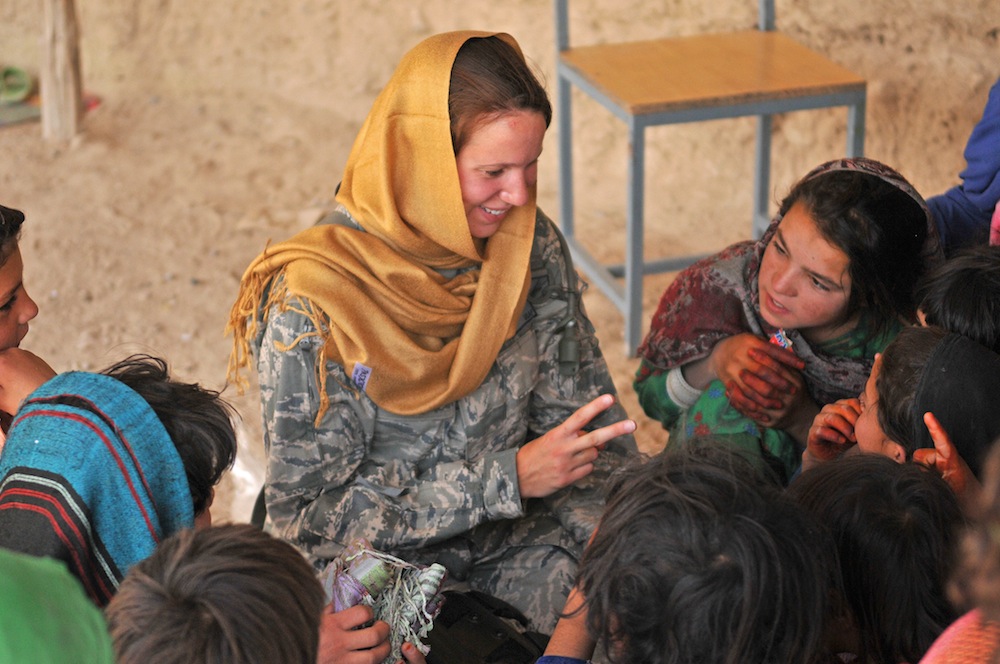
Had I flown halfway around the world to staple sequins to scarves?
The moondust-like sand had barely settled on my boots before I took my first fearful steps outside the jagged concertina wire. A year of anticipation, a month of training and days of traveling had led me to Zabul Province, a sprawling rural stretch of southern Afghanistan.
I landed at Forward Operating Base Smart a few days before my first mission was scheduled. This small patch of concrete and metal boxes was where I would learn that the fighting on the front lines doesn’t always mean firing a weapon.
The gritty glamour of deploying was something I used to crave, even though I had never really tasted it.
That attitude changed when I realized I was following in my older sister’s footsteps, by spending my first year of marriage separated from my husband by a war zone. I would also miss my other sister’s wedding, and a million other moments with my family.
With boots on the ground, I felt the weight of those future memories fall on my shoulders more heavily than my armored vest.
A Hidden School
I shifted uncomfortably under the shrapnel-protecting garment, my body unfamiliar with the extra plates hanging on my sides. At training in the States, the vest had just the front and back plates, but in theater there were side and shoulder additions snapped and woven on for extra protection. It made me regret the days I skipped the gym.
The morning was bright as we loaded up with weapons and head scarves, and set course for a girls’ school in Zabul’s capital city, Qalat. My first mission outside the wire wasn’t to enhance security or work with the Afghan government. It was to decorate head scarves. That I’d flown halfway around the world to put jewels on cloth made me laugh.
The mine-resistant vehicle we traveled in roared through the bazaar and into the city, where we parked up on a lonely desert hill. I shouldered a green duffel bag full of at least a hundred new head scarves, and tried not to lean back, for fear of falling over. I hustled to join the five other women from my unit who had already started across the hill.
The outskirts of the city were nothing more than mud walls, where men and boys had gathered to watch us. A couple of our Army security personnel kept their eyes trained and weapons ready for anyone who came too close.
We started into the city down a rocky path barely ten feet wide. The locals trailed behind, and sometimes crept to our sides, eager for a view of the foreigners in digital camouflage. Their whispers rang loud and harsh. I didn’t know a word of the Pashto they spoke, so I caged my eyes forward and kept marching.
But the trash on the street stole my attention. Garbage was strewn about carelessly. Foul odors hung over the streets; there was even littler in the small well we passed. I couldn’t tell if it was desperation or laziness that made the place so dirty.
Turning another mud-walled corner, we arrived at the Babagok Girls’ School. Nothing gave its location away. There was no marquee heralding the school mascot. There wasn’t even a sign. We found just a rusty padlock and a creaking metal door that led into a dirt courtyard.
Foreigners would never have come into my elementary school like this…
Most of the school was outdoors. Mats and old rugs stretched over the dirt floor, while fabrics spread wide across wooden poles fought the sun’s rays overhead. Little girls knelt in the shade and stared at us, while we peeled off layers of armor and carefully draped head scarves where our helmets should have been.
I lay my rifle down cautiously in the dirt, anxious about leaving a loaded gun so close to children. Foreigners would have never come into my elementary school like this, but I quickly realized these children are used to strangers — strangers carrying guns and candy.
I expected women to be teaching here. But the teachers were wiry old men with white beards. Maybe men were the only ones who to have been educated; maybe this generation would be the first in which girls would learning something other than traditional home making.
My only prior exposure to children of the Third World was through the news, or maybe a picture story on poverty. I’d never seen such pleading eyes. My eyes jumped from face to face; I didn’t know what to make of this new heartbreak.
I used to teach gymnastics to girls the same age as the ones sitting before me, and I pictured my former students kneeling among them. The haircuts here were more ragged, and their clothes were tattered, but these girls had the same vivaciousness. Unlike the harsh chatter I heard in the streets, the girls’ whispers were like fireflies buzzing on a summer night: bright, joyful, mysterious.
We opened the Army duffel bags and began handing out the shrink-wrapped scarves. Pumpkin orange and spring green spilled out of our hands and into their tiny palms. Their shyness quickly dissolved; order turned to mild mayhem as their little hands grabbed for the plastic-covered fabric, even if they had already received one scarf.
The teachers barked at the girls to be polite, to stay seated. But soon the chaos resumed. Once each girl was clutching a shiny new headdress, our team broke out the Bedazzlers.
A Bedazzle machine is something you would have forgotten years ago, unless you had a craving for attaching cheap gemstones to all your clothes. The black plastic contraptions looked like modified sewing machines without needles. A general’s wife had donated a dozen or so of the Bedazzlers - actually, they were a knock-off version call Gem Magic - and asked us to bring them to children who had probably never had a new headscarf, much less one with rhinestones on it.
The night before this mission I sat in our less-than-sterile health clinic, sorting out the different-sized gems, one by one. Six hundred glittering pieces later, the supplies were neatly organized into packets, so we could put as many gems as possible on scarves the next morning.
Performance Anxiety
Twelve girls inside sat with their legs folded under them, on drab rugs that had lost any measure of comfort. With a Bedazzler in each hand, I knelt in a similar fashion, trying to ignore the awkward handgun strapped to my right thigh. I hated that my gun was loaded.
Murmurs floated through the small classroom, as I opened the first Bedazzler, and with wobbling hands fit a tiny gem on the teeth of the machine. I took my own scarf, placed it in the jaws and pressed hard. One click and several heartbeats later, the silver-rimmed jewel sat like a miniscule island on the golden sea of my scarf.
More whispers erupted as I held my scarf up for the girls to see, and motioned for them to let me decorate theirs.
With tentative hands, the first girl held out a frayed shawl. The grapefruit-colored fabric looped around her chocolate-colored hair and spilled onto the rug. Taking it gently, I placed it in the machine and pressed again. This time a pink jewel landed on her gauzy headscarf, and she pulled it back to study this modern marvel. Our glances collided only for a brief moment, and I was still at a loss for words. I knew nothing of their native tongue, so I silently shifted to the next girl sitting beside her, and repeated the process.
Load gem, place scarf, press hard, repeat.
I did this a dozen times before my hands stopped sweating from performance anxiety. The girls pulled, twisted and examined the glittering jewels on their scarves, apparently satisfied with my decorating skills.
In the next stuffy room I saw more girls in colorful garments: lime green, deep red, twilight blue. Their faces were just a bit younger; they were maybe six or seven years old. I couldn’t ask their ages; the interpreter was outside with another group. Kneeling again, the girls formed a half circle around me. Having watched me in the first room, they were ready, holding out their head coverings for something shiny to adorn them.
I began again, the silent air hanging thick between us as their eyes followed my hands. By now I noticed an orange stain on most of the girls’ fingers. The remnants of henna dye clung to their cuticles.
The girls never took their scarves off; they just shuffled closer and handed me the edge of their fading fabric. One small girl with a sea foam green scarf hung back, unsure of how to approach the strange girl in camouflage before her. Her classmates urged her forward, pulling her scarf in my direction. Obeying, she knelt closer to me and waited for the click of the machine.
A single gold star was enough to turn her shy expression into a grin. I knew I had won a small battle, but it took her a long time to smile.
Virginia-based writer Georganne Hassell served for four years as a public affairs officer in the U.S. Air Force.
One comment about “My Front Line Mission”
What's your view?
You must be logged in to post a comment.





February 3rd, 2012 at 11:57 am
[...] I had the honor of being published in Big World Magazine. I found this magazine by chance and instantly fell for its grassroots stories from all crevices of [...]